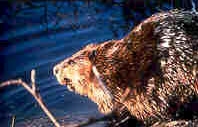
Beaver
Castor canadensis
Status
Native to both Newfoundland and Labrador.
Habitat
Usually found on slow moving streams, ponds, lakes and rivers. Beavers alter their environment to suit their needs by building dams to maintain a constant water level for lodge construction and easy access to underwater food supply.
Range
Beavers are found throughout Canada, mostly in forested areas but sometimes in the tundra or near deepwater sources surrounded by deciduous trees.
Food
Beavers eat mainly during the night since beavers are nocturnal. Typical foods include bark, leaves, twigs, buds of deciduous trees, aquatic vegetation and lily roots. Beavers prefer maple, aspen, birch, poplar, willow and alder. Before winter, the whole beaver colony gathers food. They make a cache of their favorite woody foods and place them in deep water near the lodge.
Predators/Threats
Wolves, coyotes, bears, lynx and wolverine have been known to prey on beavers. Otters can sometimes get into the lodge and kill the kits; however, an adult usually stays with the young for protection.
Lifespan
The average lifespan of beavers is 5 – 7 years in the wild. The oldest recorded in NF was 19 years.
Appearance
A beaver’s pelt is a rich brown color, with a characteristic flat tail which acts as a mechanism to frighten predators and a prop for balance when working on land; they have continuously growing orange front teeth and large rounded shape.
- Adaptations to Water: Beavers have small, beady eyes which have a transparent membrane that covers the eye when diving. Both the ears and nostrils can be closed over for underwater swimming. Large hind feet are webbed with blunt claws whereas the front feet are small with sharp claws for digging. The paws are dexterous (like hands). Beavers constantly preen themselves with their claws to maintain waterproofing. They produce the oil for this in two glands near the anus. The incisors are outside the lips so that a beaver can chew while underwater.
Breeding Biology
Beavers are monogamous (choose a single mate) animals. They breed in February and gestation takes about 110-120 days (4 months). They only produce one litter per year which consists of an average of three kits. Females can begin breeding at 32 months ( about three years). Kits leave the colony at 2 years of age.
Average Weight/Measurements
Average weight for an adult beaver is (40 – 60 lbs)(18 – 27 kg). May measure up to (4 ft)(1.3 m) long (including the tail).
Notes:
- The beaver is the largest rodent in North America and the second largest rodent in the world, next to the capybara of South America.
- The lodge is made of sticks and mud, is generally (15 ft)(4.5 m) in diameter, (5 – 7 ft)(1.5 – 2.1 m) high, with walls that are (2 – 3 ft)(0.6 – 1m) thick. It also has 2 or more underwater entrances.
- Beaver pelts helped establish Canada because they lured people further across the countryside.
- The beaver is now a national symbol.
- If a beaver is frightened, it can swim up to 7 km/hour.
- Dams are built to enhance the depth of the pond to make winter access easier.
